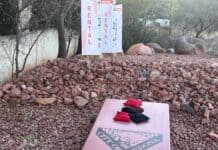The name seems like a misnomer but Hwy. 89A between Sedona and Cottonwood is experiencing what an Arizona Department of Transportation spokesman calls “raveling.”
Larson Newspapers
________________
The name seems like a misnomer but Hwy. 89A between Sedona and Cottonwood is experiencing what an Arizona Department of Transportation spokesman calls “raveling.”
The “unraveling” of the road — that is, loose pieces of rock on the surface being thrown back from tires of fast-moving vehicles — has been reported to ADOT by local drivers.
Pieces of the aggregate used to construct the road are working their way to the surface and loosening, drivers reported.
Kent Link, ADOT maintenance supervisor said that later this spring ADOT will apply a procedure called flushing, or applying a coat of oil to the road, “When materials become available.”
“The asphalt is lightly bonded,” he said. “It is also happening on I-17 around Flagstaff. Usually it takes seven or eight years before the bond breaks down.”
The posted speed limit on sections of the highway is 65 mph and traffic often moves at 75 mph or faster, causing rocks to be flung at a high velocity.
Link said he has received only one complaint.
“It’s pretty normal. We do it [flushing] all over the district,” he said.
“There is no recourse with the contractor” that built the road, Link said.
One daily commuter, Eric Mageary, said he has sustained significant damage to his vehicle that is directly caused by the road raveling.
“The composition of the road changes where the road crosses the Dry Creek Bridge. The sounds changes and it sounds like you are on a gravel road,” Mageary said.
Motorists are encouraged to report issues with raveling of the road to the ADOT Office of Risk Management at 1-602-712-7327 or the ADOT Flagstaff district office at 1-928-774-1491.
